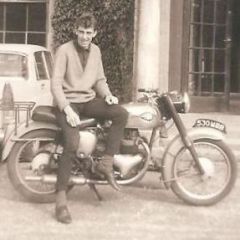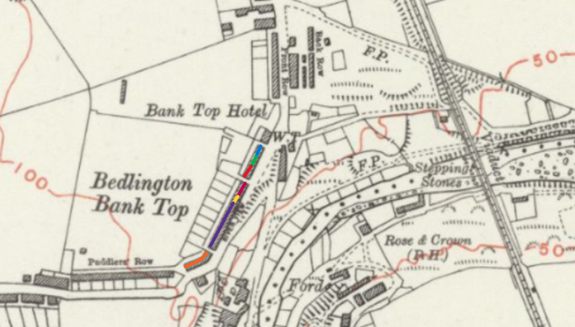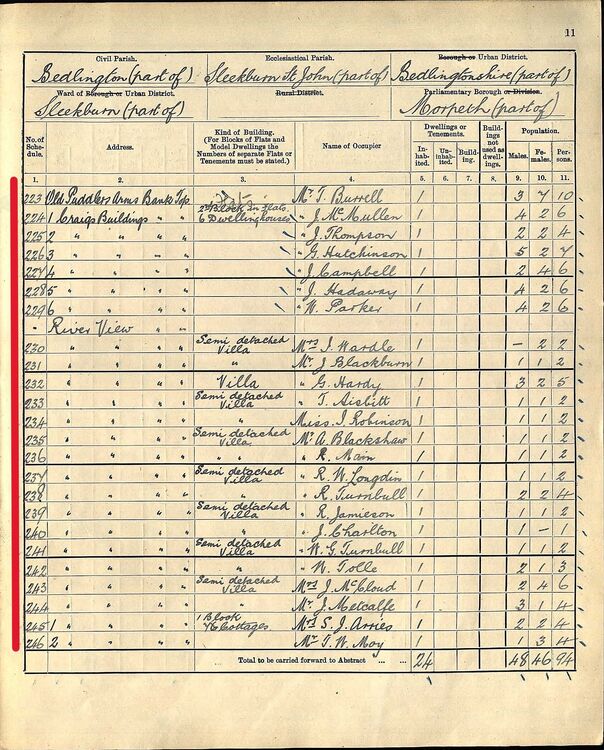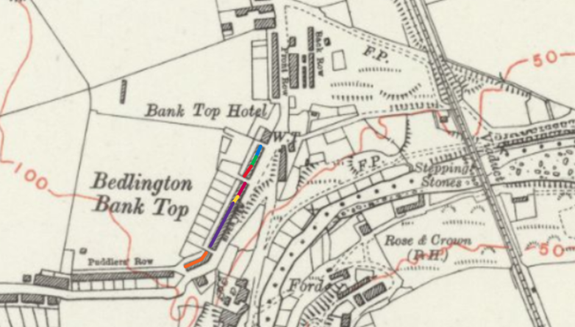.jpg.cdd7f8371d17e2f2f2e2a0e21e02f727.jpg)
Canny lass
Supporting Members-
Posts
3,578 -
Joined
-
Last visited
-
Days Won
402
Canny lass last won the day on July 1
Canny lass had the most liked content!
Reputation
1,406 ExcellentAbout Canny lass
- Birthday 13/01/1947
Profile Information
-
Gender
Female
-
Location
Where ever I lay my (incandescent, purple) hat
Recent Profile Visitors
71,833 profile views
-
Sounds as though they've hired 'the Donald'!
-
Your great grandfather, James Scott, also worked as an agricultural labourer. In 1901 when Ralph gives his occupation as Farmer/butcher, James is working with his brothers on the farm as a labourer. In 1903 he is still in the area, presumably working at Westfield, when he marries. His children are born: Ralph at Springhill, just a stone's throw away from North Sunderland, Mary Jane is, in fact, born at Westfield and Henry at Elford - also a stone's throw away from North Sunderland. It's not clear if James was living at Westfield or elsewhere. The children may have been born at the homes of Mary Jane's relatives which was quite a common occurance. Mary Jane, your great grandmother, was from Norham, which is also on the map just south west of Berwick so she was a local lass. By 1911 James and his family have made the move from North Sunderland to Holborn about 11 miles south of Berwick on Tweed. It is here he becomes a farmer, working for himself at West Holborn. Lowick Beal. Address: Farm House, Holborn West. (See https://historicengland.org.uk/listing/the-list/list-entry/1156167 for map and better photo or ‘drive’ past on Google maps as I did). The farm is now a grade 2 listed building. If you’d like any of the documentation from which I’ve taken this info leave your e- post address in my mail box (move your marker over my ‘hat’ and choose ‘message’. It’s not wise to leave it here on site.
-
@Susan J-D Hi again! This may be long! I don’t know how well you know the area so I’ll start with a map which covers most of the places I’ll mention: Berwick, Seahouses, Bamburgh, Wooler, Lowick, Belford and Chathill. North Sunderland isn’t shown but it’s almost part of Seahouses. It’s not a huge area as you see. Your great grandfather James and his father, Ralph, didn’t jointly have a farm. They had 2 quite separate places and I can’t say if they owned or rented them. Ralph, who would be your 2x great grandfather, was an agricultural labourer at the age of 19 living with his widowed mother in New Bewick near Wooler. 10 years later, in 1871, he is married and living in the small village of North Sunderland, adjacent to Seahouses on the north east coast and is a butcher. He seems to live here for many years with the same neighbours and his children are all born here. In 1891 he gives his occupation as “Butcher & farmer” and he is now self-employed, so he has presumably taken over a farm – rented or bought. He employs his sons: George as his butcher’s assistant and Ralph jr – 13 years old - as a shepherd. Just where the farm is located isn’t clear from the documentation available other than that it is in North Sunderland, In 1911 the farm address is given as “Westfield, Chathill”, which is about 9 miles north of Alnwick and 3 miles inland from the North Sea coast between Seahouses and Bamburgh. I think it’s fair to presume that it is still the same farm. He now gives his occupation as “Farmer”only so he seems to have given up butchering – possibly to his son George. His sons, Ralph jr, & John, and daughter Annie work for him. As Annie is a dairy maid it may be a dairy farm. Ralph dies in 1913 and I can see that his son, Ralph jr. seems to take over the farm. In 1921 he is still single and running the farm together with his unmarried sister, Annie, as housekeeper. Today, Westfield is a B & B guest house.
-
Hi again @Susan J-D. It’s been a cold, wet weekend here which gave me time to have another look at your question. I still think that Coney Garth may be the home farm for Bothal Castle – which was originally the manor house before being granted the rights to call itself a castle. As a manor house under the feudal system, it would certainly have a home farm. As I said before, the home farm was usually close to the manor house and that would certainly make Coney Garth a respectable contender. However, I have to admit that I have been assuming that Coney Garth (marked red on the map) and Coneygarth Moor Farm (marked blue on the map) were the same thing. A more thorough rummage through the old maps has shown me that this was not the case. Coney Garth has been named on maps since at least 1805 and, while the small cluster of buildings to its east have appeared an equally long time, it is not until 1921 that the name Coneygarth Moor appears. Your great grandfather, James Scott, seems (according to the births of his sons James and Thomas John) to have moved the 40 or so miles from Lowick to Ashington at some point roughly between 1914 and 1921. Just where he moved to is difficult to say but certainly in 1921 he was living and working at Coneygarth Moor Farm in the Bothal Demesne and he was still there in 1939. He did not own the farm though, as you say, he was a farm owner prior to his move to Ashington – as was his father before him. James was, in 1921, a farm steward - a very respectable position - employed by the Ashington Coal Company who owned the farm – as well as the remaining seven largest farms in the area. All 8 farms were run by one farm manager; George Preston Graham, and he lived in one of the large houses on Woodbine Terrace (marked yellow on the map) just a stone’s throw from your great grandfather. At that time Ashington Coal Company was owned by the Portland family who lived at Bothal Castle (which is still owned and occupied by their descendants), so indirectly James was employed by the lord of the manor – the Duke of Portland. He, and his Ashington Coal Company, seem to have been good employers. They built many houses for workers in both the mines and on the farms and one purpose of the farms was, in fact, to supply food for the workers. They had a milk ration of 2 quarts a day and even the farm cats had a ration of 1 pint a day! If you have seen your great grandfather’s address given as “Home Farm” on any document then Home Farm would seem to be Coneygarth Moor Farm rather than Coney Garth. I find it surprising that Coneygarth Moor farm should be the home farm as it is considerably less in size than Coney Garth – which, having had a good look around the maps, seems to be by far the largest in the area as well as being located nearest to the manor house. Let us know how you get on at the Northumberland Archives!
-
@Susan J-D Have you considered that Home Farm and Coney Garth may be one and the same thing? The name “Home Farm” is traditionally used to refer to any farm that is part of the manor house’s demesne – often the farm lying closest to the manor house. These were often farmed by a farm manager, hired by the lord of the manor, to cater for the needs of his household while other land was rented out to tenant farmers. Looking at this map from 1859 you can see that Coney Garth (centre), located between Ashington and Pegswood, is a considerable size and just a stone’s throw from Bothal Castle (bottom left) and also part of the Bothal Demesne. Of course, your relative may not have worked for the lord of the manor. Much depends upon when your relatives lived there. The name Home Farm can live on for centuries after being used as such.
-
That is horrendous, Malcolm!! What is politics coming to? It sounds as if we are in America, but we are in Bedlington! It just makes no sense at all.
-
It's confirmed on NCC's website. Well done Malcolm! https://beta.northumberland.gov.uk/elections/2025-county-council-election-results-summary
-
I know very little about the content of the photo I posted above. I inherited it, and a lot of other material, many years ago from a former colleague and fellow researcher. Today I did a quick bit of research on Routledge’s Buildings. They may well have been several buildings – if the number of families living in them is anything to go by. In 1881 there were 25 families living in Routledge’s Buildings, Barrington. Nothing is known of the size of the individual family’s accommodation. One resident is Jane Routledge, a 62 year old widow, living with her two daughters of 20 and 15 years and her two sons, Robert 23 years and John 18 years, all with their roots in Cowpen and Bebside. In 1891 there are 31 families living in Routledge’s Buildings. Most accommodation seems to be of 2 rooms per family though the occasional 3 or 4 room dwelling does appear. John Routledge is still in the same house. In 1901 there are 27 families in Routledge’s Buildings. John Routledge is still there. The number of rooms per family varies from 2 to 5, though mostly 2. All in all, there are 74 rooms accounted for in the census returns for the address. Clearly, that is many more than would possible in the building on the photo. Next step – look at the building on maps! On the following map, dated 1896, I can clearly see that Routledge’s Buildings is infinitely bigger than in the photo. Furthermore, it appears to be built in two blocks. I’d suggest therefore that the photo is only part of Routledge’s buildings.
-
@7RIrF This is the only picture I have of Routledge Buildings. As you see it's not a row or terrace. It's just a 'building'. In my experience most of the addresses including the word "buildings" were exactly that - a building. It's a bit misleading that it's usually in the plural form 'buildings'. As for the name they usually, but not always, take their name from the surname of the owner. If you can yell me just which census you found Routledge Buildings in I can probably help you a bit more. What exactly do you mean by "(Blank) Buildings"?
-
Well! That was a nice little wander around a place I love, and looking so much better than it's ever done before. Thank you Malcolm for all your hard work.
-
@loopylou I can certainly agree that Clarkes Cottages and the Craigs Bldgs adjoining the Puddler's Arms are one and the same thing. My only reservation is that the 4 dwellings of Craigs Bldgs have become 9 dwellings in Clarkes Cottages - but it is possible. However, I'd be hesitant to say that Millfield Cottages are the same thing as the flats in Craigs Bldgs. It seems like an odd thing to call a flat a cottage. It needs some more work. If we get a bit of rainy weather this week I'll have another look at the area. Have you read any of the posts in the topic "Puddlers Raa (Row)"? There's some interesting info from people with first-hand knowledge of the area. You'll need to get your wellies on to read it as you'll have to 'wade' through a lot of info which isn't directly related to Puddler's Row. We do tend to digress a bit on this forum! One of the things you'll find in the topic is this photo of Liddle's buildings from 1910. The angle on the corner suggests to me that it may be the building marked in orange here. It's definitely on a corner!
-
-
Make a cup of tea, there's no way of explaining this quickly! This may throw a little light on the mystery! The enumerator for Bedlington, District 9 in the 1911 census, was one J W Gaskin. He appears to have been a man who took his work very seriously. Going above and beyond the call of duty in meticulously recording the statutory requirements: name, age, birthplace etc. of each person he recorded even a brief description of the building in which the residents lived. From these descriptions I think its now possible to identify the buildings at Bank Top – at least in 1911. @loopylou Yesterday you described the census for 1911 in the following manner. (I’ve taken the liberty of colour coding your text so that I can compare them to census records, photos and maps. Unfortunately I can't use coloured text here). You said: “No. 1 Craggs (missing, a shop? Uninhabited?) BLUE No. 2 Craggs Buildings (Weightman) BLUE No. 3 Craggs Buildings (Elliott) BLUE No. 4 Craggs Buildings (Kinghorn) BLUE following these are Old Puddlers Arms (Mawson) GREEN Old Puddlers Arms (Thain) GREEN Old Puddlers Arms (Cole) GREEN Old Puddlers Arms (Burrell) GREEN All of these addresses ”Old Puddlers Arms” have two rooms each, which equates with the eight rooms described in the auction. then confusingly Craggs Buildings (no number) (McMullen) RED No. 2 Craggs Buildings (Thompson) RED No. 3 Craggs Buildings (Hutchinson) RED No. 4 Craggs Buildings (Campbell) RED No. 5 Craggs Buildings (Hadaway) RED Craggs Buildings (no number) (Parker) RED These also had two rooms each. Then after follows River View. It would appear that No. 2/3/4 are duplicated, but I do not think that these are the same properties, rather that the end six properties later become No. 9-14 of Craggs.” Let's ompare that with what the enumerator says. The enumerator describes the buildings these people lived in as follows: P 10: Sch nrs. 217 – 219 “Craigs Buildings, 1 block of 4 cottages” (1 unoccupied therefore only 3 sch. Nrs.) BLUE P 10: Sch nrs. 220 – 223 “Old Puddler’s Arms, 1 block 4 dwelling houses” GREEN P 11: Sch nrs. 224 – 229 “Craigs Buildings 2nd block in flats, 6 dwelling houses” RED There after follows River View starting with “a semi-detached villa, a villa, 6 more semi-detached villas and then 1 block 7 cottages”. If we transfer that information to a map (this one from 1924 as it’s the nearest I have) it looks like this: Following on from the red marking of Craigs Buildings, 2nd block, I’ve marked the enumerator’s description of River View: semi detached villa (pink), villa (yellow) and 7 semi-detached villas (purple), 1 block of 7 cottages (orange). If we then transfer that information to the 1930s photo it looks like this: There are a couple of questions that arise: The unmarked space between the blue marking and the green marking has no immediate explanation from the enumerator. I would suggest that it could be one of the 3 houses, each with four rooms, described in the 1864 advert as these are “adjoined” to the Puddler’s Arms. If this is the case then it should be marked BLUE. Much depends on the location of the outer wall of the Puddler’s Arms – to the right of or to the left of the unmarked space? In total, the three cottages have 12 rooms. The advert dated 1869 includes 6 double cottages of 2 rooms each. This also gives a total 12 rooms, so these could be the 3 roomed cottages mentioned in 1864. An alternative explanation for the space would be that it was occupied by the 2-roomed cottage offered for sale with the Puddler’s Arms in 1869 as part of the same lot for sale in 1869. If this is the case then it should be marked GREEN. To me it seems that, at least in 1911, the large building contained not only the public house (to the right) but also 6 flats (to the left). I’ve said before that housing was at a premium due to the need for a greatly increased workforce in Bedlington. Perhaps the Puddler’s Arms originally occupied the whole of the building but renting out accommodation may have given the opportunity to provide a better income – for infinitely less effort.
-
That's the first picture I've ever seen. Hadn't heard about the fire either. Thanks!

.thumb.jpg.7493ddab4a696108cf2b849323d3c155.jpg)






















